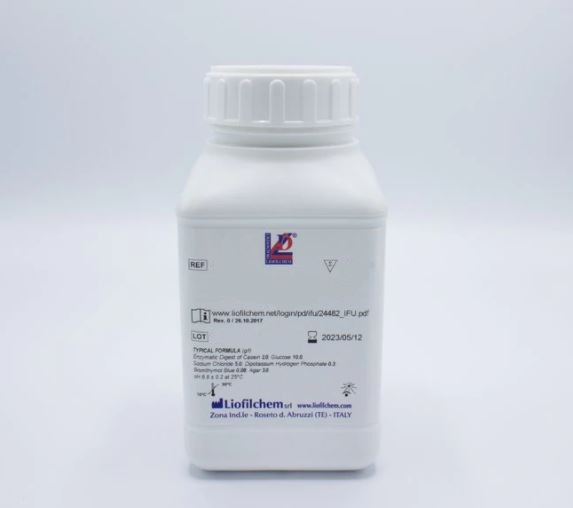Specifications:
| Application | Microbiology | ||
| Product Type | Culture Medium | Forms | Powder |
| Product Brand | Liofilchem | ||
| Product Grade | Microbiology grade | ||
Liofilchem Bile Aesculin Agar is a selective and differential microbiological medium designed for the isolation and preliminary identification of Group D streptococci, including enterococci. This medium is particularly valuable for applications in food microbiology and pharmaceutical quality control, where distinguishing these organisms is critical. The medium utilizes the hydrolysis of esculin to detect the presence of Group D streptococci, producing a visually distinct black or brown coloration around colonies for positive identification.
Key Features
- Selective Isolation: Includes oxgall (bile salts) to inhibit the growth of Gram-positive bacteria other than Group D streptococci and enterococci.
- Differential Identification: Hydrolysis of esculin and subsequent black complex formation with ferric citrate enables easy differentiation.
- Versatile Applications: Suitable for use in food safety testing, pharmaceutical product quality control, and other microbiological research or monitoring tasks.
- Reliable Performance: Provides reproducible results with optimized composition and preparation protocols.
- Long Shelf Life: Dehydrated medium is stable for up to four years under proper storage conditions.
Typical Composition (g/L)
- Beef Extract: 3.0 (provides nutrients and growth factors)
- Meat Peptone: 5.0 (source of amino acids and nitrogen)
- Esculin: 1.0 (differential substrate for Group D streptococci)
- Oxgall: 40.0 (selective agent to inhibit non-target Gram-positive bacteria)
- Ferric Citrate: 0.5 (reacts with aesculetin for color change)
- Agar: 14.0 (solidifying agent)
- Final pH: 6.4 ± 0.2 at 25°C
Principle of Action
- Selective Growth:
- Oxgall (dehydrated bile) inhibits the growth of most Gram-positive bacteria, allowing only Group D streptococci and enterococci to proliferate.
- Differentiation Mechanism:
- Esculin is hydrolyzed by Group D streptococci, producing aesculetin and dextrose.
- Aesculetin reacts with ferric citrate to form a distinct dark brown or black precipitate around colonies, confirming a positive result.
- Nutrient Support:
- Beef extract and meat peptone provide essential nutrients and energy for bacterial growth.
Preparation Instructions
- Suspend 63.5 g of the dehydrated medium in 1 liter of deionized or distilled water.
- Heat to boiling while stirring until the powder is completely dissolved.
- Sterilize the solution in an autoclave at 121°C for 15 minutes.
- Allow the sterilized medium to cool to 45–50°C, then pour into sterile Petri dishes.
- Let the medium solidify before use.
Technical Use Cases
1. Food Microbiology
- Objective: Detect the presence of Group D streptococci and enterococci in food products as part of microbial safety analysis.
- Application:
- Processed meat, dairy products, and fermented foods are tested for contamination by these organisms.
- Critical for ensuring compliance with food safety regulations.
2. Pharmaceutical Quality Control
- Objective: Evaluate the microbial quality of non-sterile pharmaceutical products.
- Application:
- Detection of specified microorganisms, including Group D streptococci, in raw materials and finished products.
- Conformance with pharmacopeial standards like EP 9.0 and other microbiological testing guidelines.
3. Environmental Microbiology
- Objective: Monitor microbial contamination in environmental samples.
- Application:
- Water testing, especially in settings requiring the identification of fecal contamination indicators.
- Suitable for assessing hygiene in food-processing facilities or pharmaceutical manufacturing sites.
4. Clinical and Veterinary Research (Limited)
- While not intended for diagnostic use in humans, the medium may be used in research settings to study Group D streptococci as part of veterinary investigations or microbiological studies.
Procedure for Use
- Inoculation:
- Streak the test sample (food, pharmaceutical, or environmental) directly onto the agar surface.
- Incubation:
- Place the plates in an incubator set to 36 ± 1°C for 18–24 hours in an aerobic atmosphere.
- Observation:
- Observe for bacterial growth and any black/brown coloration surrounding the colonies.
Interpretation of Results
- Positive Result:
- Growth with blackening of the medium around colonies indicates esculin hydrolysis by Group D streptococci or enterococci.
- Negative Result:
- Growth without color change or inhibition of growth indicates the absence of Group D streptococci or inability to hydrolyze esculin.
Quality Control Standards
| Microorganism | Expected Result |
|---|---|
| Enterococcus faecalis ATCC 19433 | Good growth with blackening. |
| Streptococcus pyogenes ATCC 19615 | Inhibited growth. |
- Inoculum for Productivity: 50–100 CFU.
- Inoculum for Selectivity: 10⁴–10⁶ CFU.
Storage Guidelines
- Dehydrated Medium: Store at 10–30°C in a dry environment, tightly sealed in its original container.
- Prepared Medium: Store at 2–8°C, away from light.
- Use before the expiration date or discard if signs of contamination or deterioration are observed.
Packaging Options
- 100 g Bottle: Ref. 620210.
- 500 g Bottle: Ref. 610210.
- 5 kg Bottle: Ref. 6102105.
Safety and Precautions
- For professional laboratory use only.
- Adhere to proper laboratory practices when preparing and handling the medium.
- Refer to the provided Safety Data Sheet (SDS) for hazard and handling information.
Liofilchem Bile Aesculin Agar is an effective tool for the selective isolation and differentiation of Group D streptococci, ensuring reliable identification in food, pharmaceutical, and environmental samples. Its robust formulation, clear interpretation, and adherence to microbiological standards make it indispensable in quality control and research laboratories.
- Pack Size: 100g 500g 5kg




 0
0
